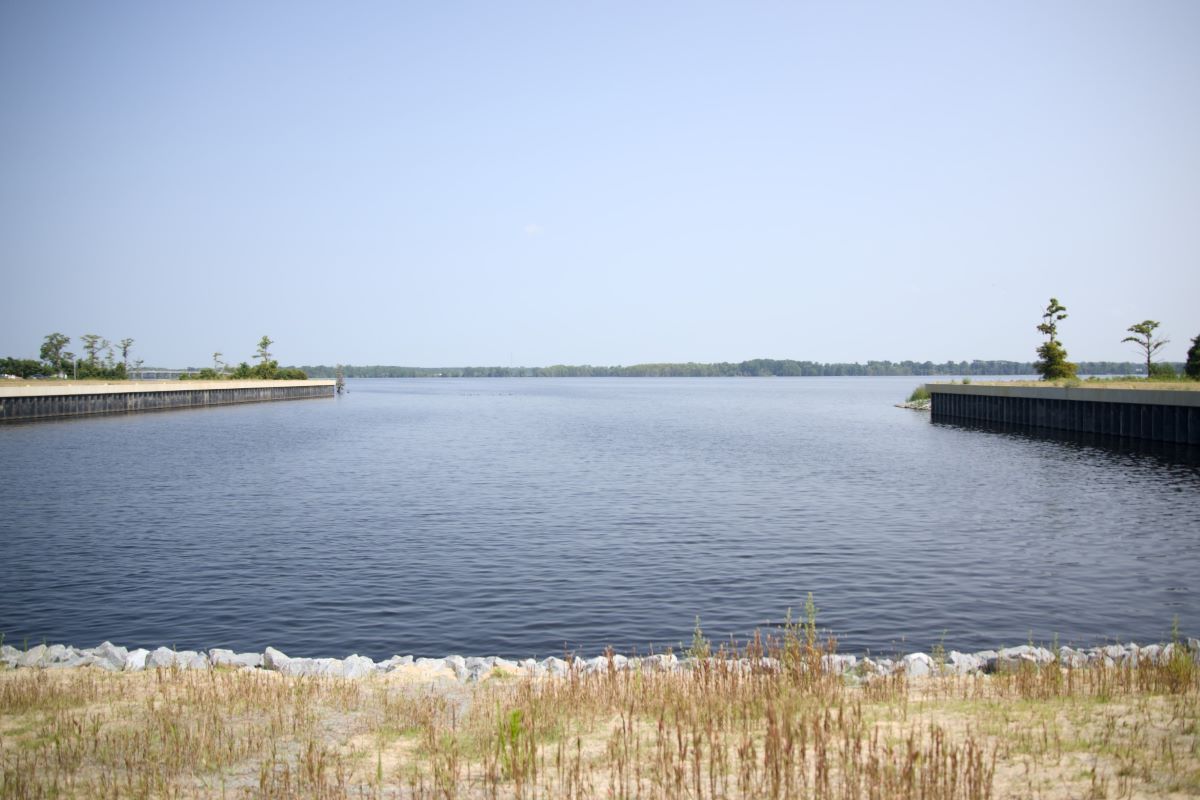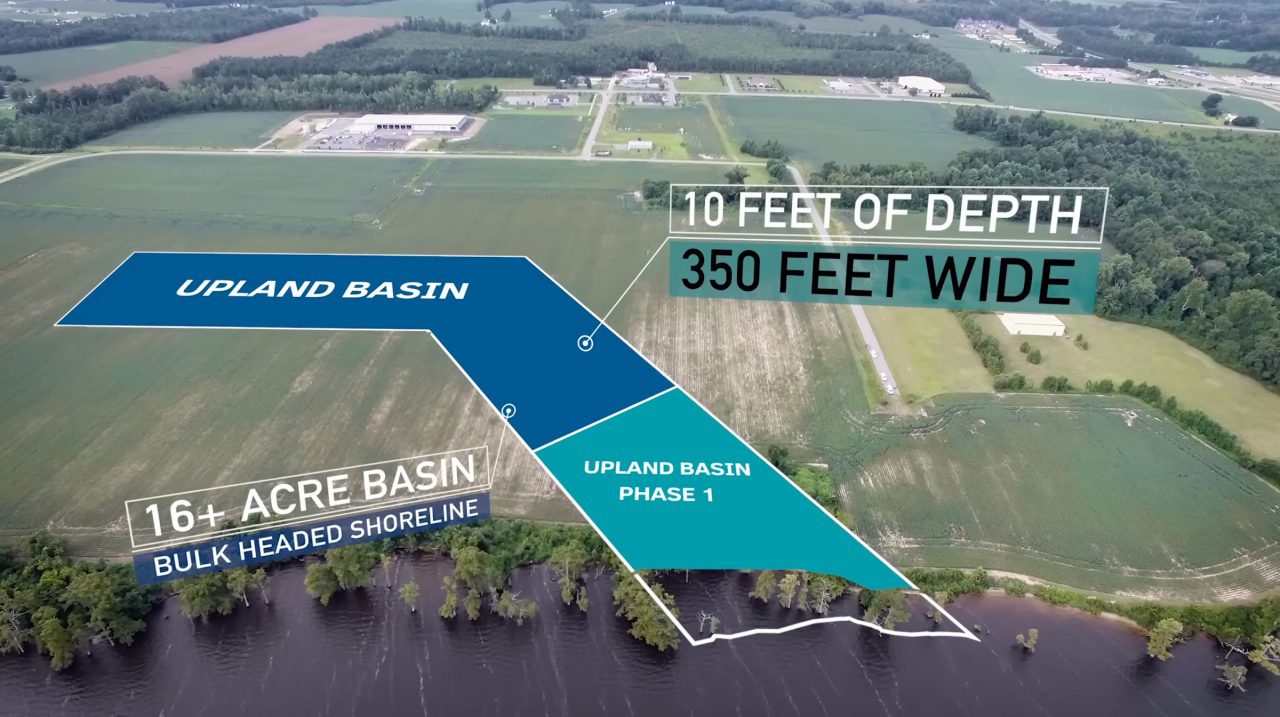
The Perquimans River is a narrow, twisting coastal river that never leaves Perquimans County.
It’s rarely more than 50 or 60 feet wide until it suddenly opens up just upriver from Hertford, the county seat. As it passes Durants Neck a little more than a mile south of the town, the river becomes a broad estuarine waterway offering a direct route to the Albemarle Sound.
Supporter Spotlight
County Manager Frank Heath stood recently on the edge of a wide, bulkheaded boat basin telling Coastal Review about the Perquimans County Marine Industrial Park that, after more than 10 years of false starts and missed steps, finally completed the first phase of the project last year: The $7 million deep-water boat basin now allows direct water access to the Albemarle sound.
“It’s 350 feet wide, more than a football field in width, and it goes inland 700 feet,” he said. “We do have such spectacular water resources, to me, it makes sense that we start with this.”
For some time, there have been calls to develop the county’s water access. More than 65 years ago in 1958, in celebration of the bicentennial of the founding of Hertford, W.G. Newby compiled “Town of Hertford Bi-Centennial” note, among other historic facts, “One of the very important contributing factors in the growth of a town is transportation. We have here … a great and beautiful river, the Perquimans.”

The author went on to note that by 1958 the river “is only used by a fleet of oil tankers that supply oil of home, U.S. Navy and other uses. However, it could be put to work of industry and we hope some day that this will come to pass.”
The basin, Heath explained, is phase one and it took a while to complete that first step in developing the county’s waterfront for commercial use.
Supporter Spotlight
“We spent quite a bit of energy getting the grants for phase one,” he said.
Getting the first phase completed, began Heath said, “12 or 13 years ago” when North Carolina identified Hertford as a secondary marine resource when the Wanchese Marine Industrial Park ran out of space.
It was, Heath explained, a much-needed economic lifeline for the county.
“The textile industry left in the 1980s and ’90s, we had several good-sized factories, those shut down,” he said. “We have an agricultural-based economy, which is very important, and we want that to continue to thrive, but we also want other industries to come in.”
Originally a state project, as plans moved forward, it became apparent that the state was not in position for the grants needed to build the marina project.
“What they found as … a state entity, they weren’t eligible for state grants, like the county would be. So, they transferred the ownership back to the county, and in the past, say, four years, we have been piecing funds together to get this done,” Heath said.
The county’s plan for the marina targets companies that need water access for large scale construction projects as likely tenants for the marina.
“There are builders from this area and outside the region, we’ve talked to companies that are looking to reshore back (return manufacturing) into United States,” Heath said.
At least one company has moved from Hampton Roads to Hertford. East Coast Steel Fabrication, a company providing heavy steel fabrication for barges and marine structures, is located immediately adjacent to the basin, although it is not part of the marina.

Heath mentioned there have been contacts with potential customers for the marina, although any announcement remains months in the future.
“I would think by the beginning of next year, we would have some news, if not sooner,” he said. “I’d love to have something before the end of the year.”
There is still work to be done.
There is not yet a road to the basin. Heath mentions the county is working with the North Carolina Department of Transportation on getting a road built.
“I’ve worked in cooperation with NCDOT. They’ve helped me do cost estimates and preliminary drawings, and I included that in requests that I’ve sent to the General Assembly to try to get funded through a budget process,” Heath said, adding that the budget impasse in the state legislature this session has stalled funding.
As a short-term solution, the county does have the funds to put in a gravel road something Heath said would be done in the next three months.
Phase two of the project will include a substantial extension of the boat basin, although Heath is careful to not get ahead of himself.
“We spent quite a bit of energy getting the grants for phase one. For grants for phase two to open up, getting the current basin leased out, is going to be important, because it proves the case itself. So, my primary goal now is to market to potential companies that need that kind of access,” he said.
Perquimans County is not considered an economically distressed county by North Carolina. The state uses a three-tier rating system, with Tier 1 being the most distressed and counties with a rating of 3 having the healthiest economies.
Perquimans County falls squarely in the Tier 2 category, but at least part of that economic health is created by workers who don’t work in the county.
“Our goal is to create jobs here in Perquimans County,” Heath said. “We have a lot of people that go to Hampton Roads to work, and we’d like to give them a place at home to work.”
That would, he noted, be more convenient for the workers, but there is more to it than that. Workers employed in the county also spend money in the county.
“They could buy gas here, they could buy lunch here. You’re going to stop by the grocery store and stop by the hardware or the auto place where you work,” Heath said. “We want to recapture that leakage.”








